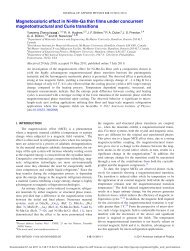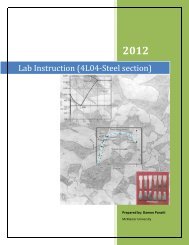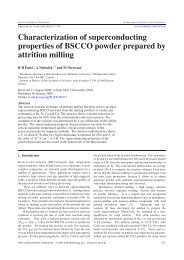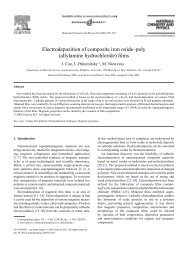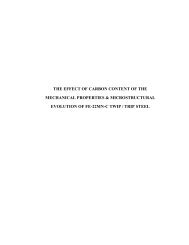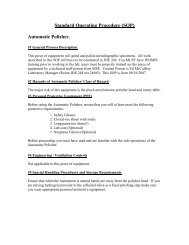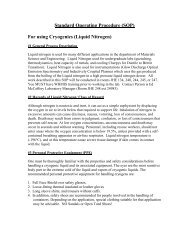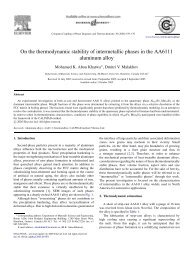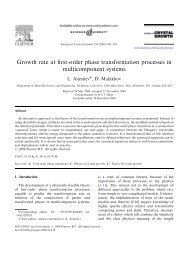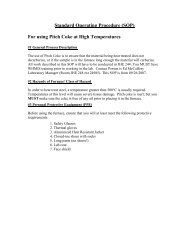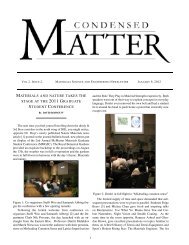E407-07 Microetching Metals and Alloys.pdf - McMaster Department ...
E407-07 Microetching Metals and Alloys.pdf - McMaster Department ...
E407-07 Microetching Metals and Alloys.pdf - McMaster Department ...
You also want an ePaper? Increase the reach of your titles
YUMPU automatically turns print PDFs into web optimized ePapers that Google loves.
conform to specifications of the Committee on Analytical<br />
Reagents of the American Chemical Society where such<br />
specifications are available. Other grades, such as United States<br />
Pharmacopeia (USP), may be used, provided it is first ascertained<br />
that the reagent is of sufficiently high purity to permit its<br />
use without detrimental effect.<br />
7.2.1 Unless otherwise indicated, references to water shall<br />
be understood to mean reagent water as defined by Type IV of<br />
specification D1193. Experience has shown that the quality of<br />
tap water varies significantly <strong>and</strong> can adversely affect some<br />
etchants.<br />
7.3 Methanol is usually available only as absolute methanol.<br />
When using this alcohol it is imperative that approximately 5<br />
volume % of water is added whenever an etchant composition<br />
calls for 95 % methanol. Some of these etchants will not work<br />
at all if water is not present.<br />
7.4 For conversion of small liquid measurements, there are<br />
approximately 20 drops/mL.<br />
7.5 Etching should be carried out on a freshly polished<br />
specimen.<br />
7.6 Gentle agitation of the specimen or solution during<br />
immersion etching will result in a more uniform etch.<br />
7.7 The etching times given are only suggested starting<br />
ranges <strong>and</strong> not absolute limits.<br />
7.8 In electrolytic etching, d-c current is implied unless<br />
indicated otherwise.<br />
7.9 A good economical source of d-c current for small scale<br />
electrolytic etching is the st<strong>and</strong>ard 6-V lantern battery.<br />
7.10 In electrolytic etching, the specimen is the anode<br />
unless indicated otherwise.<br />
7.11 Do not overlook the possibility of multiple etching<br />
with more than one solution in order to fully develop the<br />
structure of the specimen.<br />
7.12 Microscope objectives can be ruined by exposure to<br />
hydrofluoric acid fumes from etchant residue inadvertently left<br />
on the specimen. This problem is very common when the<br />
specimen or mounting media contain porosity <strong>and</strong> when the<br />
mounting material (such as Bakelite) does not bond tightly to<br />
the specimen resulting in seepage along the edges of the<br />
specimen. In all cases, extreme care should be taken to remove<br />
all traces of the etchant by thorough washing <strong>and</strong> complete<br />
drying of the specimen before placing it on the microscope<br />
stage.<br />
<strong>E4<strong>07</strong></strong> − <strong>07</strong> ´1<br />
Copyright by ASTM Int'l (all rights reserved); Thu Sep 20 10:14:59 EDT 2012<br />
3<br />
Downloaded/printed by<br />
MC MASTER UNIVERSITY pursuant to License Agreement. No further reproductions authorized.<br />
7.13 Tint etchants (13, 14-16) are always used by<br />
immersion, never by swabbing, as this would inhibit film<br />
formation. An extremely high quality polish is required as tint<br />
etchants will reveal remaining polishing damage even if it is<br />
not visible with bright field illumination. After polishing, the<br />
surface must be carefully cleaned. Use a polyethylene beaker<br />
to contain the etchant if it contains fluorine ions (for example,<br />
etchants containing ammonium bifluoride, NH4 FHF). The<br />
specimen is placed in the solution using tongs, polished face<br />
up. Gently agitate the solution while observing the polished<br />
surface. After coloration begins, allow the solution to settle <strong>and</strong><br />
remain motionless. Remove the specimen from the etchant<br />
when the surface is colored violet, rinse <strong>and</strong> dry. A light<br />
pre-etch with a general-purpose chemical etchant may lead to<br />
sharper delineation of the structure after tint etching.<br />
7.14 Specimens should be carefully cleaned before use of a<br />
vapor-deposition interference film (“Pepperhoff”) method (13,<br />
14-17). A light pre-etch, or a slight amount of polishing relief,<br />
may lead to sharper delination of the constituents after vapor<br />
deposition. The deposition is conducted inside a vacuum<br />
evaporator of the type used to prepare replicas for electron<br />
microscopy. One or several small lumps of a suitable dielectric<br />
compound with the desired index of refraction is heated under<br />
a vacuum until it evaporates. A vacuum level of 1.3 to 0.013 Pa<br />
(10 −3 to 10 −5 mm Hg) is adequate <strong>and</strong> the polished surface<br />
should be about 10–15 cm beneath the device that holds the<br />
dielectric compound. Slowly evaporate the lumps <strong>and</strong> observe<br />
the surface of the specimen. It may be helpful to place the<br />
specimen on a small piece of white paper. As the film thickness<br />
increases, the surface (<strong>and</strong> the paper) will become colored with<br />
the color sequence changing in the order yellow, green, red,<br />
purple, violet, blue, silvery blue. Stop the evaporation when the<br />
color is purple to violet, although in some cases, thinner films<br />
with green or red colors have produced good results.<br />
7.15 <strong>Metals</strong> H<strong>and</strong>book (18) provides additional advice on<br />
etching solutions <strong>and</strong> techniques for various alloys.<br />
8. Precision <strong>and</strong> Bias<br />
8.1 It is not possible to specify the precision or bias of this<br />
practice since quantitative measurements are not made.<br />
9. Keywords<br />
9.1 etch; etchant; interference method; metallography; metals;<br />
microetch; microscope; microstructure; Pepperhoff<br />
method; tint etch




